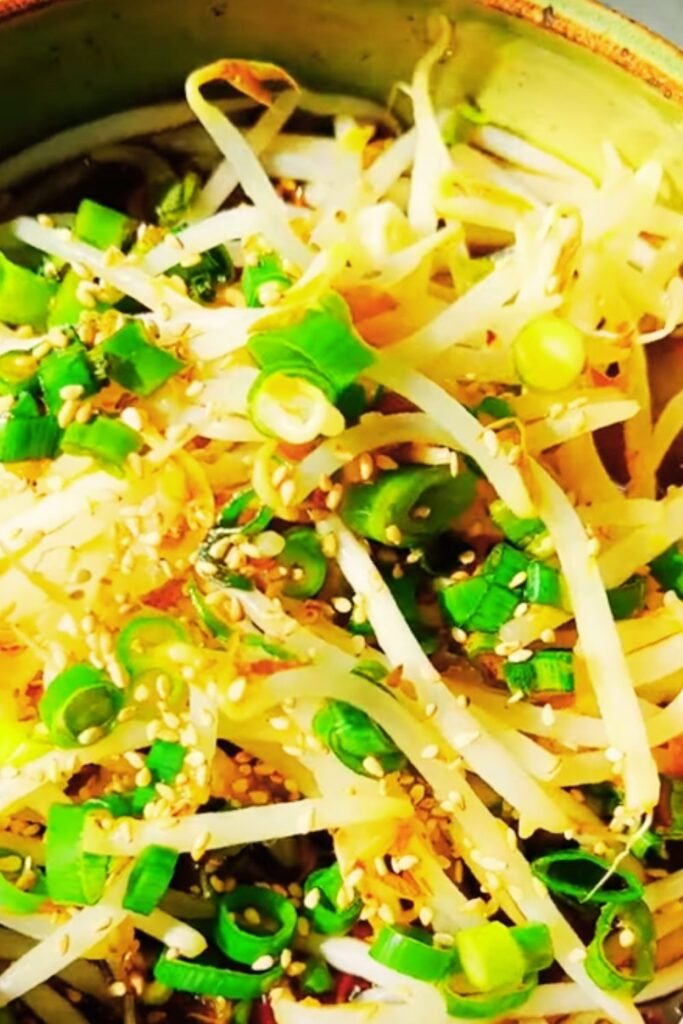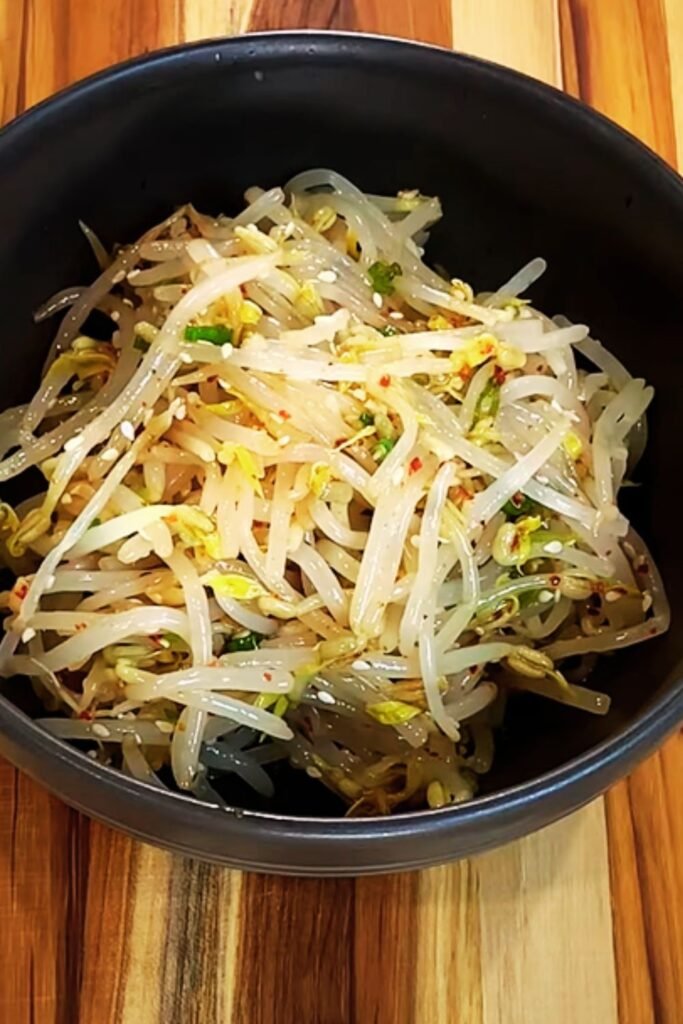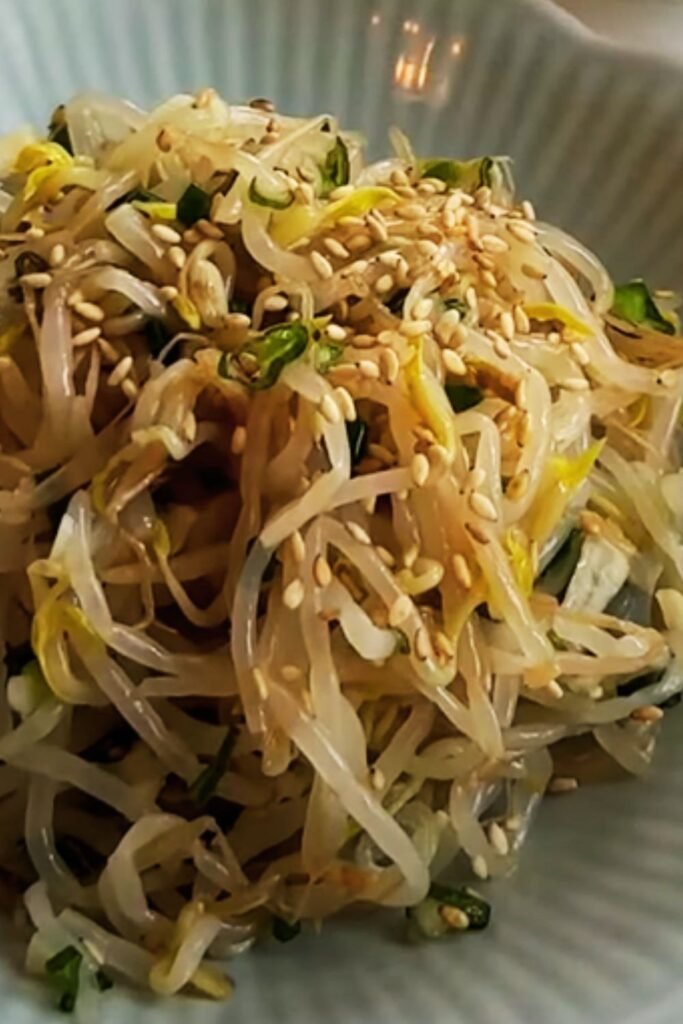When I first tasted Korean spicy bean sprouts at a small Seoul restaurant three years ago, I knew I had discovered something extraordinary. The combination of crisp texture, fiery heat, and umami depth completely transformed my understanding of what a simple vegetable side dish could be. Today, I’m sharing everything I’ve learned about this incredible Korean staple that has become a weekly fixture in my kitchen.
Korean spicy bean sprouts, known as kongnamul-muchim (콩나물무침), represent the perfect marriage of simplicity and complexity that defines Korean cuisine. These aren’t your average bland bean sprouts – they’re transformed into a vibrant, addictive side dish that packs serious flavor punch while maintaining that satisfying crunch we all crave.
Understanding Korean Bean Sprouts: More Than Just a Garnish
Bean Sprouts (Kongnamul): Fresh soybean sprouts that serve as the foundation of this dish, characterized by their white stems and small yellow heads.
Muchim: A Korean preparation method involving seasoning and mixing vegetables with various aromatics and seasonings.
Banchan: Korean side dishes served alongside rice and main courses, of which spicy bean sprouts is one of the most popular.
Gochugaru: Korean red pepper flakes that provide the dish’s signature heat and vibrant red color.
The beauty of Korean bean sprouts lies in their versatility and nutritional profile. I’ve discovered that these humble sprouts contain impressive amounts of vitamin C, protein, and fiber while remaining incredibly low in calories. What fascinates me most is how Korean cooks have elevated this simple ingredient into something that can steal the spotlight from any main dish.
My Essential Ingredients Breakdown

Through countless experiments in my kitchen, I’ve identified the crucial components that make or break this dish. Here’s what you absolutely need:
Primary Ingredients:
- Fresh soybean sprouts (1 pound)
- Korean red pepper flakes (gochugaru) – 2-3 tablespoons
- Garlic cloves – 4-5 pieces, minced
- Green onions – 3-4 stalks, finely chopped
- Sesame oil – 2 tablespoons
- Salt – 1 teaspoon (or to taste)
- Sugar – 1 teaspoon
- Rice vinegar – 1 tablespoon
- Toasted sesame seeds – 1 tablespoon
Optional Flavor Enhancers:
- Fish sauce – 1 teaspoon (for deeper umami)
- Soy sauce – 1 tablespoon
- Fresh ginger – 1 teaspoon, minced
- Korean pear or apple – 1 tablespoon, grated (for subtle sweetness)
The quality of your bean sprouts makes an enormous difference. I always look for sprouts with crisp white stems and bright yellow heads. Avoid any that appear slimy or have brown spots – these will result in a mushy, unappetizing final product.
Step-by-Step Preparation: My Foolproof Method
Preparation Phase:
- Rinse the bean sprouts thoroughly under cold running water
- Remove any dark or damaged sprouts
- Prepare all aromatics while sprouts drain
- Set up your blanching station with ice water ready
Blanching Process:
- Bring a large pot of salted water to a rolling boil
- Add bean sprouts and blanch for exactly 30 seconds
- Immediately transfer to ice water bath
- Drain thoroughly and squeeze out excess water gently
- Pat dry with clean kitchen towels
Seasoning and Assembly:
- Combine gochugaru, minced garlic, salt, and sugar in a large mixing bowl
- Add the blanched and dried bean sprouts
- Drizzle sesame oil and rice vinegar over the mixture
- Add chopped green onions and any optional ingredients
- Mix everything together using clean hands or tongs
- Taste and adjust seasoning as needed
- Garnish with toasted sesame seeds
The key insight I’ve gained through practice is the importance of proper water removal. Excess moisture dilutes the flavors and creates a watery dish that lacks the punch you’re seeking.
Nutritional Profile and Health Benefits
| Nutrient | Per 1 Cup Serving | Daily Value % |
|---|---|---|
| Calories | 85 | 4% |
| Protein | 6.2g | 12% |
| Carbohydrates | 8.4g | 3% |
| Dietary Fiber | 3.8g | 15% |
| Vitamin C | 14.2mg | 24% |
| Folate | 120mcg | 30% |
| Vitamin K | 45mcg | 56% |
| Manganese | 0.3mg | 15% |
| Phosphorus | 85mg | 8% |
| Magnesium | 28mg | 7% |
What impresses me most about this dish is how it delivers substantial nutrition while remaining incredibly low in calories. The fermented elements and spices also contribute beneficial probiotics and anti-inflammatory compounds that support digestive health.
Flavor Variations I’ve Perfected

Mild Version (Family-Friendly):
- Reduce gochugaru to 1 tablespoon
- Add 1 tablespoon honey for balance
- Include grated apple for natural sweetness
- Perfect for introducing children to Korean flavors
Extra Spicy Version:
- Increase gochugaru to 4 tablespoons
- Add 1 teaspoon Korean chili paste (gochujang)
- Include fresh sliced jalapeños
- Finish with a pinch of cayenne pepper
Umami-Rich Version:
- Add 2 teaspoons fish sauce
- Include 1 tablespoon soy sauce
- Mix in 1 teaspoon anchovy paste
- Garnish with crispy fried garlic
Citrus-Forward Version:
- Replace rice vinegar with fresh lime juice
- Add lime zest
- Include thinly sliced jalapeños
- Perfect for summer meals
Storage and Meal Prep Strategies
| Storage Method | Duration | Quality Notes |
|---|---|---|
| Refrigerator (covered) | 3-4 days | Best texture first 2 days |
| Freezer | Not recommended | Texture becomes mushy |
| Room temperature | 2 hours maximum | Food safety concern |
| Meal prep containers | 3 days | Separate wet ingredients |
My meal prep strategy involves blanching large batches of bean sprouts on Sunday and storing them separately from the seasoning mixture. This allows me to quickly assemble fresh portions throughout the week while maintaining optimal texture and flavor.
Serving Suggestions and Pairings
Korean spicy bean sprouts shine as part of a traditional Korean meal, but I’ve discovered numerous creative applications:
Traditional Korean Pairings:
- Served alongside Korean BBQ (galbi or bulgogi)
- As part of a bibimbap bowl
- With Korean fried chicken
- Accompanying kimchi jjigae (kimchi stew)
Modern Fusion Applications:
- Topping for grain bowls
- Side for grilled fish or chicken
- Mixed into Asian-style salads
- Garnish for ramen or pho
Complementary Banchan:
- Kimchi for fermented tang
- Pickled radish for cooling contrast
- Seasoned spinach for color variety
- Korean cucumber salad for refreshing balance
Troubleshooting Common Issues
Problem: Watery or soggy texture Solution: Ensure thorough draining and gentle squeezing after blanching. Pat completely dry before seasoning.
Problem: Lack of flavor penetration Solution: Mix seasonings first, then add sprouts. Allow 15-20 minutes for flavors to meld before serving.
Problem: Too spicy or too mild Solution: Adjust gochugaru gradually. Remember that flavors intensify over time.
Problem: Sprouts become mushy Solution: Reduce blanching time to 20-25 seconds. Ensure ice bath is properly cold.
Advanced Techniques I’ve Mastered

Temperature Control: I’ve learned that maintaining precise water temperature during blanching is crucial. The water should be at a full rolling boil, and the blanching time should never exceed 30 seconds. This preserves the signature crunch while ensuring food safety.
Seasoning Distribution: The secret to even flavor distribution lies in the mixing technique. I always start with dry seasonings, create a paste-like consistency with minimal oil, then gradually incorporate the vegetables. This ensures every sprout gets coated evenly.
Texture Optimization: For maximum crunch retention, I’ve discovered that gentle handling is essential. Never squeeze the sprouts aggressively – instead, use a pressing motion with clean kitchen towels to remove excess moisture.
Cultural Significance and Regional Variations
Korean spicy bean sprouts hold deep cultural significance beyond their culinary appeal. In Korean households, this dish represents the philosophy of making extraordinary food from ordinary ingredients. Each region of Korea has developed subtle variations that reflect local preferences and available ingredients.
Seoul Style: Tends toward higher spice levels with emphasis on garlic Busan Style: Often includes seafood elements like dried anchovies Jeju Style: Features local citrus elements and milder heat profiles North Korean Style: Traditionally uses less oil and more vinegar
Professional Tips from My Korean Cooking Mentors
Through my relationships with Korean home cooks and professional chefs, I’ve gathered invaluable insights:
Timing is Everything: The best kongnamul-muchim is served within 30 minutes of preparation when the flavors are bright and the texture is at its peak.
Quality Matters: Invest in high-quality gochugaru from a Korean grocery store. The difference in flavor complexity is remarkable compared to generic red pepper flakes.
Balance is Key: Korean cuisine emphasizes harmony between sweet, salty, spicy, and umami elements. Taste frequently and adjust accordingly.
Seasonal Awareness: In summer, increase the vinegar slightly for a more refreshing profile. In winter, add a touch more sesame oil for richness.
Q&A Section
Q: Can I use mung bean sprouts instead of soybean sprouts? A: While mung bean sprouts can work, I strongly recommend soybean sprouts for authentic flavor and better texture retention. Soybean sprouts have a nuttier taste and sturdier structure that holds up better to the seasoning process.
Q: How can I reduce the sodium content without sacrificing flavor? A: I’ve successfully reduced sodium by using less salt and compensating with additional rice vinegar and a small amount of grated ginger. The acidity and aromatics help maintain flavor complexity while reducing overall sodium levels.
Q: Is this dish suitable for meal prep? A: Absolutely! I prepare large batches regularly. The key is storing the blanched sprouts separately from wet seasonings until ready to serve. This maintains texture quality for up to 4 days in the refrigerator.
Q: What’s the best way to adjust spice levels for different family members? A: I prepare a base version with minimal gochugaru, then provide additional seasoned gochugaru mixture on the side. This allows each person to customize their heat level without preparing multiple batches.
Q: Can I make this dish without blanching the sprouts? A: While some recipes suggest using raw sprouts, I’ve found that brief blanching significantly improves both safety and digestibility while maintaining the desired crunch. The 30-second blanch is worth the extra step.
Q: How do I know if my bean sprouts are fresh enough to use? A: Fresh bean sprouts should have crisp white stems, bright yellow heads, and no slimy texture or off odors. Avoid any with brown spots or wilted appearance. Fresh sprouts should snap cleanly when bent.
Q: What’s the difference between this and other Korean bean sprout dishes? A: Kongnamul-muchim is specifically the seasoned side dish version. Other preparations include kongnamul-bap (bean sprout rice) and kongnamul-guk (bean sprout soup), each with distinct preparation methods and flavor profiles.
Q: Can I freeze prepared Korean spicy bean sprouts? A: I don’t recommend freezing this dish as the texture becomes unpleasantly soft upon thawing. The cellular structure of bean sprouts doesn’t handle freezing well, resulting in a mushy consistency that lacks the characteristic crunch.
Korean spicy bean sprouts have become more than just a recipe in my kitchen – they represent the beautiful simplicity and depth that make Korean cuisine so compelling. This dish teaches us that with the right techniques and quality ingredients, even the most humble vegetables can become something extraordinary. Whether you’re preparing a full Korean feast or simply want to add some excitement to your weeknight dinners, mastering kongnamul-muchim will elevate your cooking repertoire and introduce you to the addictive world of Korean flavors.
The journey of perfecting this dish has taught me patience, precision, and the importance of respecting traditional techniques while allowing room for personal creativity. I encourage you to start with the basic recipe and gradually develop your own variations based on your family’s preferences. Remember, the best Korean cooking comes from understanding the fundamental principles and then applying them with confidence and creativity.